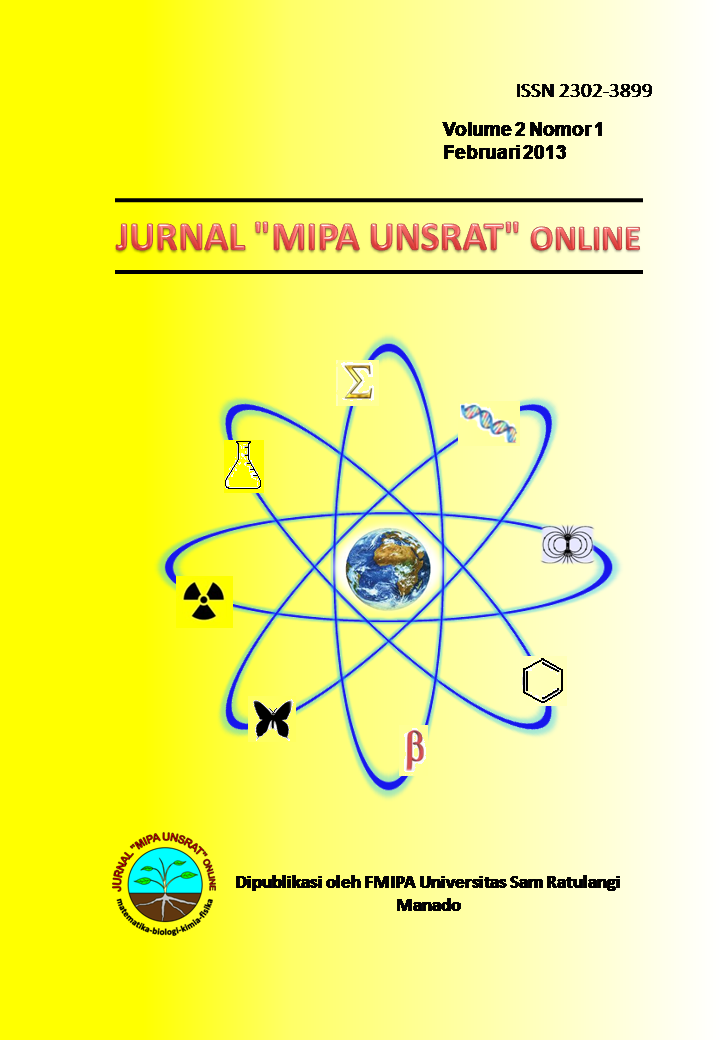Profil Lipida Plasma Tikus Wistar yang Hiperkolesterolemia pada Pemberian Gedi Merah (Abelmoschus manihot L.)
DOI:
https://doi.org/10.35799/jm.2.1.2013.765Abstract
Tujuan penelitian ini adalah untuk mempelajari pengaruh daun gedi merah (Abelmoschus manihot L.) terhadap kadar lipida dari plasma darah hewan uji yang menderita hiperkolesterolemia. Penelitian ini menggunakan 16 ekor tikus jantan, strain Wistar berumur 2-3 bulan dengan berat 120-250 g, dan dibagi dalam 3 tahap perlakuan. Tahap pertama, tikus diadaptasikan terlebih dahulu selama 8 hari dengan pemberian pakan standar, dan diakhiri masa adaptasi, sebanyak 3 ekor tikus dibedah untuk dianalisis kadar lipida plasmanya (Baseline). Tahap ke-2, tikus diberi pakan aterogenik selama 14 hari untuk meningkatkan kadar kolesterol plasmanya, dan diakhiri tahap ini sebanyak 3 ekor tikus dibedah untuk dianalisis kadar lipida plasmanya (kelompok Aterogenik). Tahap ke-3, tikus dibagi menjadi dua perlakuan, yakni: tikus yang diberi pakan standar (kelompok PS), dan tikus yang diberi pakan standar mengandung 36% pasta daun gedi merah (kelompok PG). Setiap perlakuan terdiri dari 5 ekor tikus dan diakhiri tahap perlakuan ini, semua tikus dibedah untuk dianalisis kadar lipida plasmaya menggunakan metode enzimatik kolorimetri. Pemberian pakan sebanyak 20 g per ekor per hari dan air minum dilakukan secara ad libitum. Hasil penelitian menunjukkan bahwa kelompok PG secara signifikan memiliki kadartotal plasma cholesterol (TPC) yang lebih rendah daripada baseline, kelompok aterogenik dan PS, kelompok PG juga memiliki kadar kolesterol dalam partikel low density lipoproteins (k-LDL) lebih rendah daripada kelompok aterogenik, dan kelompok PG memiliki kadar trigliserida (TG) yang lebih rendah daripada kelompok aterogenik dan PS. Penelitian ini menyimpulkan bahwa mengkonsumsi pakan standar mengandung 36% pasta daun gedi merah dapat menurunkan kadar TPC, k-LDL dan trigliserida berpengaruh nyata terhadap penurunan kolesterol tikus percobaan yang hiperkolesterolemia.
The purpose of this research was to study the effect of red gedi (Abelmoschus Manihot L.) leaves on the blood plasma lipid levels of the tested animals suffering from hypercholesterolemia. This study used 16 Wistar strain male rats, 2-3 months old with the body weight of 120 to 250 g. The tested animals were divided into three groups based on the treatments stages. At the first stage, all rats were adapted for 8 days with the standard food and at the end of the treatment 3 rats were dissected for plasma lipid level analysis (the baseline group). At the second stage, all rats were received atherogenic feeding for 14 days to increase the plasma cholesterol levels and at the end of the treatment 3 rats were dissected for plasma lipid level analysis (the atherogenic group). At the third stage, the rats were divided into two groups of treatments: the PS group and the PG group Each group consisted of 5 rats. The rats in The PS group were fed with standard food and the PG group were fed with the standard food containing 36% of red gedi leaf paste. At the end of the treatment, the rats were dissected for plasma lipid level analysis using enzymatic colorimetric methods. During the treatments, each rat was received 20 g of food and drinking water ad libitum. The results showedthat the total plasma cholesterol (TPC), low density lipoprotein cholesterol (LDL-C), and triglyceride levels of the rats receiving red gedi (the PGgroup) were lower compare to the other groups (thebaseline, theatherogenicandPS groups). This studyconcludedthat consumingthe standardfoodcontaining 36% of redgedileaf paste was able to reduce the cholesterol levels of hypercholesterolemiarats.






